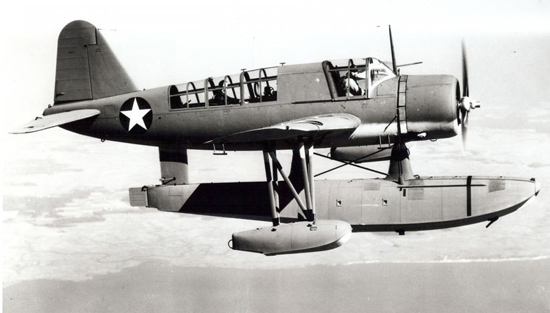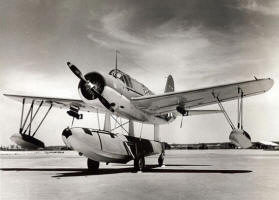|
|

Marine Corps Vought OS2U Kingfisher # 5351 crashed in Chiricahua Mountains in southeastern Arizona, October 12, 1941
Summary: The pilot of the Kingfisher, Marine Corps Flight Sergeant Edward "Mac" McMahon, was ferrying the aircraft from New York to San Diego. While on the East Coast, he picked up a passenger, 23 year-old Navy Radio Operator Oscar Rohrer, who was trying to get to his home in San Diego to visit his wife on furlough. On the afternoon of October 12, the two men departed El Paso at 4:15 in the afternoon and set a heading for Tucson, Arizona. As the aircraft approached the Chiricahua Mountains it began to encounter cloudbanks which obscured Flight Sergeant McMahon's visibility. As he began to fly up a sharply rising canyon near the small mountain town of Paradise, he concluded he did not have the altitude necessary to clear the mountain range and banked hard to the left to reverse his course back out of the canyon. Just as he almost completed his turn, his left wing struck a tall Juniper tree which caused his aircraft to crash onto the mountainside. Tragically, McMahon was killed in the crash, but amazingly, his passenger Navy Radioman Oscar Rohrer was catapulted from the crashing aircraft and only suffered a broken nose and lacerations on his forehead. Despite bleeding profusely, he managed to hike down the canyon until he was rescued by local ranchers who heard the crash and formed a search party and headed up the mountain. Investigators concluded that had McMahon turned a mere 20 feet earlier he would have missed the large Juniper tree. When I had crouched down to take a picture, I saw something roll out of the dirt and rest against my boot. It had a unique shape, so I picked it and wiped away the dirt and was very surprised to see it was McMahon's metal USMC globe and anchor insignia. Unfortunately, Oscar Rohrer passed away a few years ago. However, his family greatly appreciated the information and photos I passed on as they had no documentation of the crash and only knew what he had told them. I had very little information on Edward McMahon until April of 2011, when I received an email from his son who came across my website while researching his father. He also mentioned that his 97 year old mother, Mac's wife, was alive. It was a satisfying feeling to be able to return the USMC pin to Mac's family and have it mean so much to them. The pin finally made it home to Mac's wife after 70 years. |
|
|
|
|
|
| Vought part number stamps and a 'USN' on the aluminum. | The exhaust manifold. | Hudraulic line and other miscellaneous parts. | Steel tubing. |
|
|
|
|
|
| The engine throttle. | Seat belt harness. | A bomb shackle. | Close-up of the data plate. |
|
|
|
|
|
| Although the Kingfisher was a floatplane, it also had landing gear for runway landings. | Another landing gear. | Bomb shackle, landing gear and other components. | More debris. |
|
|
|
|
|
| An instrument case. | Data tag on the back of the case. | Molten aluminum. | An access door. |
|
|
|
|
|
| Holding part of the landing gear beneath the old Juniper tree. | An aftershave bottle. | Data tag. | The brass casing to a shotgun shell. |
 |
| A kingfisher with retractable landing gear for hard surface landings. |